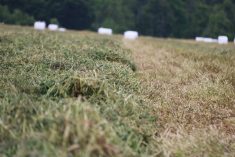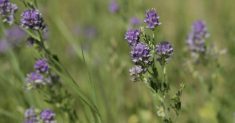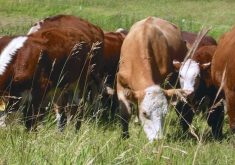It’s been one of the latest starts on record for forage, but 2022 still has the potential to be the province’s first decent hay year since 2017.
John McGregor, extension support with the Manitoba Forage and Grassland Association (MFGA), says the first alfalfa clippings of the year are now in for analysis.
“It is slow right now, but with a bit of heat, I’m sure it’s going to take off,” he said.
Read Also

Still hard to predict precise fertilizer payback
Despite decades of advances, international research finds no clear answer for where and when adding nutrient will fail to boost growth.
Why it matters: Temperatures throughout May largely failed to clear 20 C while late April and early May had seen a string of storms that reburied parts of Manitoba with snow and sent others under water.
With normal ‘Hay Days’ — the day pegged in each region by the MFGA for ideal harvest — in early to mid-June, however, there is little doubt that first cut will be delayed.
The association’s Green Gold hay monitoring program had yet to release a report as of June 3. Weekly Green Gold reports typically start to flow in the latter half of May, and continue until alfalfa samples in the province reach optimal harvest feed value for high-quality alfalfa.
Samples, however, are not typically taken until stands reach 10 inches high. A report released by the MFGA in mid-May put the most advanced alfalfa stands at around three to four inches in eastern Manitoba, while fields in western Manitoba lagged at one to two inches.
The news was better for grasses, more suited to growing in a cooler-than-normal May. The MFGA put grasses at two to four inches high as of mid-May.
As of the first week of June, sampled alfalfa stands were coming in at 12 to 16 inches tall, with some straggling back at eight inches, according to McGregor. Grasses had hit the three- to four-leaf stage, finally opening up the grazing season for most producers, although McGregor noted that wet or flooded pastures had added a whole other issue in some areas.
“The alfalfa has probably only seen half of the growing degree days that it needs to get into that bud stage,” McGregor said. “If we’re looking at high-quality alfalfa, we still need another 150 growing degree days, and then the window after that is probably another week before you’ve lost the top quality and you’re starting to go into a little bit lower-quality alfalfa.”
Pushing back the first cut may impact whether farmers can get in their second or third, McGregor acknowledged — or not, he added, depending on how quickly weather brings on the second flush — but the typically higher yield of the first cut may offset some of that sting.
Most producers can likely fit a second cut before stands start to set their winter reserves, regardless of the delay, he added, “and if the conditions continue with moisture and heat… they can also take that last cut late into October,” after plants start to go dormant.
“It’s like every year with alfalfa,” he said. “The biggest concern is not so much when you cut, it’s more, when you cut, are we going to get rain that’s going to spoil the quality of the alfalfa.”
David Wiens, chair of the Dairy Farmers of Manitoba, says fields are about 10 days behind their normal early-June starting date, although much will depend on temperatures in the coming days.
“There were quite a few farms that were scrambling to get feed together last fall,” he said. “It’s problematic. Every day or week that is delayed this spring is certainly not helping that situation.”
Good when it gets here
This year, at least, there is plenty of moisture to go around.
Unlike last year, when drought strangled hay stands and producers were forced to choose between harvesting at high quality, and getting very little, or trading quality for biomass, producers have hope that yields and quality will both be good once the cut arrives.
“I don’t see any reason why we wouldn’t expect some very good-quality hay,” McGregor said.
Wiens agreed, saying that, “there’s still potential for things to come together very nicely,” should conditions turn favourable and if the periodic storms seen so far this year let off.
Carson Callum, general manager of the Manitoba Beef Producers, said forage is growing “decently,” although stands are variable across the province, he said.
“There’s a couple of challenges here still,” he said. “We’ve got lots of moisture, but the heat hasn’t come, so it could be growing a lot better if we had those heat units. And, unfortunately, with this moisture, some folks’ fields are under water.”
Overland flooding issues are still widespread, he said. A number of beef producers have applied for disaster assistance funding, either due to calving losses during earlier storms or infrastructure losses due to flooding, according to Callum.
Problems for tomorrow
The impact of a first-cut delay, compounded by drought stress built up over a string of poor growing years, will have to be added into the calculation when it comes to later cuts this season.
Callum urged producers to take that stress into consideration. At the same time, he said, conditions in the last few years, like the extensive growth seen last fall, made it difficult to balance the line between harvesting as much forage as possible, while respecting the period where plants set their reserves.
“We’ve done this in years before where we’ve cut alfalfa at 24 inches high just because we’re sitting at the 17th of June,” McGregor said, adding that, “your window is getting narrower once we get past the middle of June to go for that third cut before the critical harvest period in the beginning of August. “
It is Wiens’ hope that conditions will allow for a quick turnaround on the second cut, which may then open the door for a third.
“I think there would be very good prospects for a second cut, but third cut will depend on the timing,” he said.
Annual crops
Delay in the first cut presents a conundrum for producers who also have to get annual grains in the ground, Wiens pointed out.
Seeding has taken on urgency in Manitoba, with wet and flood conditions keeping farmers off the land. The province’s weekly crop reports put seeding at 40 per cent complete as of the fourth week of May, a time when producers are typically over 90 per cent done.
“Certainly from the dairy side, there’ll be a lot of people still trying to finish up seeding as first cut is approaching,” Wiens said.
Silage corn, like other annual crops, has likewise been an issue to get planted, with producers banking on an open fall to allow proper maturity in the increasingly popular feed crop.
“We’re getting later and later in that stage, so we might find that some of the corn silage yields may not be as good as (farmers) would normally want,” McGregor said.
Again, he said, so much will depend on weather in the coming weeks and months.
Dairy producers are prioritizing corn in their seeding plans, Wiens said. He added that the province may well see variety switching to quicker-maturing options, something that will come with its own yield impacts.
Otherwise, he said, producers may well switch some planned corn acres for cereal greenfeed or silage.
“We do have some producers in those areas where last year they were in the worst of the drought and this year they’re in kind of the wettest part of the province, so that’s been rather unfortunate,” Wiens said.
“It is going to be a challenge there,” he added. “Having gone from one extreme to the other… although we’re still early in the season in terms of summer, again, in some cases, there’s going to have to be other strategies pursued here that are still, maybe not the optimum, but trying to make the best out of this growing season.”
Callum said MBP has anecdotally heard of producers changing seeding plans. At the same time, he said, there is reason to hope that, whatever ends up in the ground, there will be feed coming out of it.
“I think current conditions will allow that feed to grow compared to last year where it was dust right now,” he said.
















